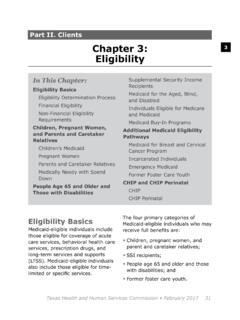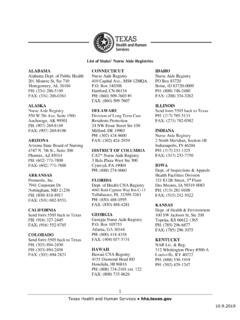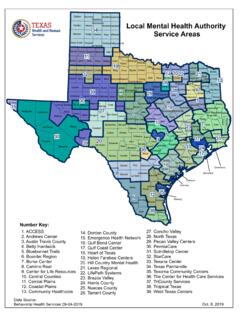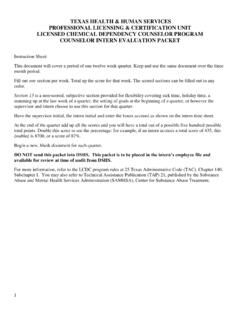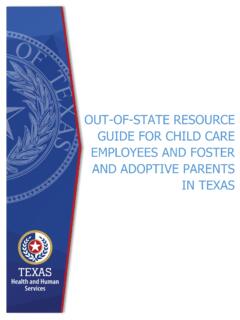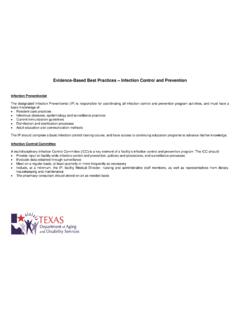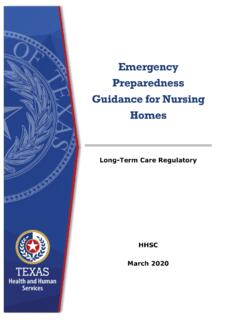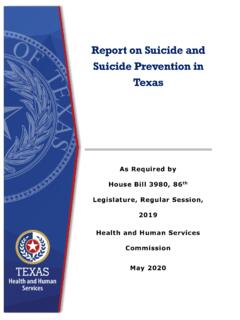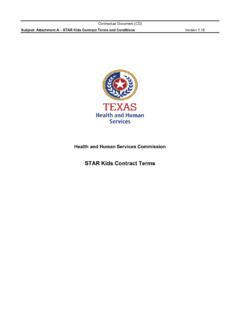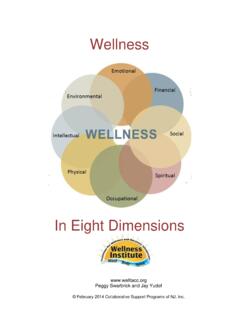Transcription of Texas Resilience and Recovery - Texas Health and Human ...
1 1 Texas Resilience and Recovery Utilization Management Guidelines: Child and Adolescent Services Updated 2016 2 Table of Contents Recovery & Resilience .. 4 SUMMARY OF CHILD AND ADOLESCENT TRR SERVICE PROVISION .. 4 TRR VALUES .. 4 LEVELS OF CARE CONTINUUM .. 5 Table 1. Texas Resilience and Recovery Levels of Care .. 7 Level of Care 0: Crisis Services .. 8 Level of Care 0 Table Overview ..10 Level of Care 1: Medication Management ..11 Level of Care 1 Table Overview ..13 Level of Care 2: Targeted Services ..14 Level of Care 2 Table Overview ..16 Level of Care 3: Complex Services ..17 Level of Care 3 Table Overview ..19 Level of Care 4: Intensive Family Services ..20 Level of Care 4 Table Overview ..23 Level of Care YES: YES Waiver ..25 Level of Care YES Table Overview ..28 Level of Care RTC: Residential Treatment Center Services ..29 Level of Care RTC Table Overview ..32 Level of Care YC: Young Child Services.
2 33 Level of Care YC Table Overview ..35 Level of Care 5: Transitional Services ..37 Level of Care 5 Table Overview ..39 Appendix A: Crisis Services and Planning ..41 SAFETY PLAN ..46 Appendix B: Training Requirements ..48 Appendix C: Selecting an Intervention ..50 Appendix D: Family Partner Supports ..58 Appendix E: Level of Care Early Onset (LOC-EO) ..60 Appendix F: Transition-Age Appendix G: Reasons for Deviation ..69 Appendix H: Provider Qualifications: Standard Requirements for Services ..85 Appendix I: Definitions ..88 References ..91 3 Children s Public Mental Health System in Texas Hope, Resilience , and Recovery for Everyone is the vision statement of the Texas Department of State Health Services (DSHS) Mental Health and Substance Abuse Division. This vision is aligned with the national movement to incorporate Resilience and Recovery -oriented services, supports, practices, and beliefs into publicly-funded mental Health service delivery models.
3 The service delivery system in Texas for community-based mental Health services is Texas Resilience and Recovery (TRR). The TRR model acknowledges that youth experiencing adverse mental Health symptoms and serious emotional disturbance (SED) are on a continuum of mental Health and have natural supports and strengths which should be built upon to foster Resilience and Recovery . TRR was designed using the System of Care philosophy, which is child-centered and family-focused, and takes into account the youth s and family s strengths and supports, as well as their needs and challenges. The modern framework of the TRR system utilizes an intensity-based approach to service delivery. This model requires the use of an internationally recognized assessment instrument, the Child and Adolescent Needs and Strengths (CANS) assessment. The CANS assessment is a comprehensive multi-purpose tool developed for children s mental Health services to support decision making, including selection of the level of care, Recovery and service planning, quality improvement initiatives, and monitoring of service outcomes.
4 The Texas CANS Comprehensive serves as the psychosocial assessment, as well as a trauma screening and suicide screening tool, for all youth entering community mental Health services in Texas . In addition, the Texas CANS comprehensive is used to determine eligibility for community mental Health services and to determine the appropriate level of care recommended under TRR services. An array of evidence-based practices (EBPs) and promising practices can be individualized in each level of care to meet the youth s needs and build upon the unique strengths of each youth. Services and supports provided via the TRR model are expected to result in improved behavioral and emotional functioning. The goals of the Utilization Management (UM) Guidelines are to increase understanding of TRR, guide the selection of levels of care and services, and serve as a reference tool for service providers. The UM Guidelines: Child and Adolescent Services manual should be distributed in its entirety to all clinical staff who serve youth and families.
5 Providing the entire manual as a readily available resource will allow clinical staff to better understand the TRR continuum of care, the services that are available for youth with more intense needs, and which lower level services will be available as youth improve in treatment. The TRR UM Guidelines do not replace or supersede existing legal requirements, legal statutes, state rules ( , Texas Administrative Code [TAC], Health and Safety Code, etc.), or Performance Contract requirements for providers contracted with DSHS. TAC (b) states: Providers must comply with the department's Utilization Management Guidelines, which are incorporated by reference, if contractually obligated to provide any mental Health community services, including mental Health rehabilitative, mental Health case management, supported housing, supported employment, or Assertive Community Treatment (ACT). The department is responsible for monitoring compliance by providers that contract with the department and the [Local Mental Health Authority] LMHA and [Managed Care Organization] MCO are responsible for requiring and monitoring compliance of providers in their networks.
6 4 Recovery & Resilience The Substance Abuse and Mental Health Services Administration (SAMSHA) defines Recovery as: A process of change through which individuals improve their Health and wellness, live a self-directed life, and strive to reach their full potential (SAMHSA, 2012). To support Recovery of individuals, SAMHSA identifies four dimensions , which are applicable to children s development across the lifespan: Health , home, purpose, and community (SAMHSA, 2012). Each of these four dimensions is addressed in the TRR LOCs. Historically, CMH service delivery models have focused on building Resilience in youth. SAMHSA defines Resilience as: Resilience refers to an individual s ability to cope with adversity and adapt to challenges or changes. Resilience develops over time and gives an individual the capacity not only to cope with life s challenges but also to be prepared for the next stressful situation.
7 Optimism and the ability to remain hopeful are essential to Resilience and the process of Recovery (SAMHSA, 2013). SUMMARY OF CHILD AND ADOLESCENT TRR SERVICE PROVISION TRR VALUES The values that serve as the foundation for the TRR model are: Child-Centered, Family-Focused: Child-centered means that youth should be engaged as equal partners in care and should have their voices heard throughout their involvement in the TRR system. The family-focused value honors the caregivers role as primary decision-makers in the care of the youth. The youth s and family s goals for Recovery are incorporated as the centerpiece that guides the Recovery plan. Involving caregivers and youth helps to ensure that culturally competent services are delivered. Engagement: Engagement emphasizes a respect for the youth s and caregiver s capabilities and their roles as part of the solution to the identified challenges. Barriers to access and participation in the appropriate level of care and Recovery services are continuously addressed.
8 Attention is placed on finding solutions to barriers to ensure that the youth and family are working together toward Recovery . Evidence-Based Practices: According to SAMHSA s Co-Occurring Center for Excellence (COCE, 2007), an EBP is a practice which, based on research findings and expert or consensus opinion about available evidence, is expected to produce a specific clinical outcome. EBPs are programs or practices that effectively integrate the best research evidence with clinical expertise, cultural competence, and the values of the individuals receiving the services. EBPs must be appropriate to the target population(s) and service settings in order to achieve desired outcomes. Fidelity: Fidelity is the extent to which a treatment approach as actually implemented corresponds to the treatment strategy as it was designed to be implemented (COCE, 2007). Appropriate implementation of an EBP with high fidelity will result in the outcomes intended by the intervention.
9 Fidelity requirements outline the manner in which specific principles, practices, and procedures are implemented. Fidelity adherence is an element of continuous quality improvement. 5 LEVELS OF CARE CONTINUUM The TRR model is comprised of a continuum of levels of care that reflect youths and families needs, strengths, and services. The System of Care framework recommends that the determination of levels of care, Recovery supports, and mental Health treatment resources be allocated based on a continuum of intensity of services guided by youths needs (Stroul and Blau, 2008). The intensity of needs in the TRR model is determined by the Uniform Assessment, which includes the CANS assessment. CANS assessment scores are used to determine youths LOCs, as well as to identify needs and strengths to be addressed in the Recovery plan. When CANS assessment scores are higher, the level of care will increase due to the youth s higher needs.
10 As the youth improves, decreased needs and increased strengths will be reflected on the CANS assessment and the level of care may decrease. The provider should utilize CANS assessment scores and clinical judgment to support deviation to other levels of care. It is important to use language that is easy for youth and families to understand, within their context of culture, level of education, and development. It is recommended that providers use Motivational Interviewing techniques when engaging a resistant individual (youth or caregiver) that is having difficulty understanding why a given LOC is the best match for the youth/family in services. It is recommended that providers collaborate with their local Certified Family Partners to help engage families in services. Providers should use the Family Guide ( ) as a resource for families starting in services. Table 1, Texas Resilience and Recovery Levels of Care Continuum, describes the levels of care.
